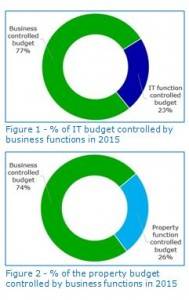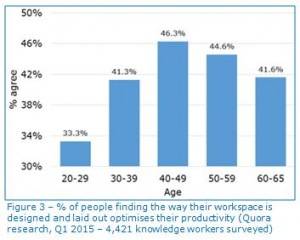 When it comes to increasing organisational output, which in turn directly relates to real wage growth and higher living standards, the only determinant is productivity, measured in terms of output per hour worked. This is at the heart of all businesses and is essential for growth. The basic facts on productivity are clear. For over a decade, productivity has been painfully weak across all the major economies. The UK has performed particularly badly, with productivity having declined by 3.7 percent since 2008. A recent OECD report went as far as saying: “weak labour productivity since 2004 has been holding back real wages and well-being. The sustainability of economic expansion and further progress in living standards rest on boosting productivity growth, which is a key challenge for the coming years”.
When it comes to increasing organisational output, which in turn directly relates to real wage growth and higher living standards, the only determinant is productivity, measured in terms of output per hour worked. This is at the heart of all businesses and is essential for growth. The basic facts on productivity are clear. For over a decade, productivity has been painfully weak across all the major economies. The UK has performed particularly badly, with productivity having declined by 3.7 percent since 2008. A recent OECD report went as far as saying: “weak labour productivity since 2004 has been holding back real wages and well-being. The sustainability of economic expansion and further progress in living standards rest on boosting productivity growth, which is a key challenge for the coming years”.
Yet all of this is in the face of a decade-long onslaught of new ‘productivity’ interventions. This begs the question, what’s happening to all these fantastic productivity initiatives? Recent research has highlighted that business leaders have lost patience with this situation and are taking direct action. This article explores the background to this unsustainable situation, what actions organisations are currently taking, and what outcomes can be anticipated.
An age of speed
Our age of speed and overload has been building for generations. Inventions such as the telegraph, cinema, railroad, and airplane have progressively reduced distance and upended our traditional temporal rhythms. However, the first high-tech revolutions that began to shift our experiences of time and space more than a century ago have substantially intensified in the last ten years.
Unlike any time in past hundred years, the last decade has seen a veritable avalanche of new ‘things’ that have accelerated our hypermobile, split-focus, cyber-centric culture.
The result of this excess of interventions is to have left the workforce continually distracted by new facilities, tools, and policies to collaborate, communicate, and connect but without the required forethought to ensure these interventions work in unison and with context.
 Our architectural and design colleagues have bombarded our workforces with a decade-long campaign of open-plan offices, hotelling, hot-desking, collaboration space, ‘communicate-collaborate-concentrate-contemplate’ spaces, ‘activity based working’, ‘spatial adjacency’. Someone even thought it was a good idea to incorporate ski gondolas in an office design.
Our architectural and design colleagues have bombarded our workforces with a decade-long campaign of open-plan offices, hotelling, hot-desking, collaboration space, ‘communicate-collaborate-concentrate-contemplate’ spaces, ‘activity based working’, ‘spatial adjacency’. Someone even thought it was a good idea to incorporate ski gondolas in an office design.
Our IT colleagues have driven us from desktops to virtualisation, laptops to tablets. We have gone from cellular to smartphones, from internet to ‘i’ everything, from GUI to cloud, USB to unified communications, with each iteration promising great productive gains. We have gone from megabyte to petabyte, all because big data is good data.
And our HR colleagues have taken workforces on a journey from personnel administration to emotional capital, from job satisfaction to employee engagement, from employment to empowerment, from training to ‘integrated capability development’, from hiring to talent analytics, from career to core competencies. We have experienced a decade of telecommuting, whether flexible working or agile working.
Without exception, all of these interventions have entered into our workplaces with the promise of untold productivity gains. Yet, the absence of clear ‘what’s in it for me’ messaging, and a lack of cohesion between the various delivery functions have only succeeded in confusing and distracting the workforce.
Interrupting science
While there’s always a number of excuses put forward to explain this dwindling productivity, everything points to one overriding factor that stands out head-and-shoulders above all others, namely ‘interruption science’.
We prize knowledge work – work that relies on our intellectual abilities – and yet the evidence is that we increasingly have no time to think.
 The greatest casualty of our mobile, high-tech, over-burdened age is attention – and by implication, productivity. By fragmenting and diffusing our powers of attention, we are undermining our capacity to thrive in a complex, ever-shifting world.
The greatest casualty of our mobile, high-tech, over-burdened age is attention – and by implication, productivity. By fragmenting and diffusing our powers of attention, we are undermining our capacity to thrive in a complex, ever-shifting world.
Beeped and pinged, interrupted and inundated, overloaded and hurried – that is how we live today and how often the average knowledge worker is interrupted, switching tasks every three minutes. Once distracted, a worker takes nearly a half-hour to resume the original task.
Amongst the mounting costs of this widespread distraction are;
- Knowledge work can’t be done in sound bites. Interruptions and the time to recover now consume 28 percent of a worker’s day.
- Employees who are routinely interrupted and lack time to focus feel 40 percent more frustrated, pressured, and stressed.
The bottom line is that business functions – those responsible for productive business outcomes – are no longer willing to be ‘gifted’ with the latest, greatest IT, or tolerate being shoehorned into inappropriate space in inappropriate locations that stifle their ability to attract, recruit and retain the right talent.
This has reached the point where recent research from the Corporate Executive Board, and corroborated by our own independent research shows that three-quarters of corporate IT and Property spend in 2015 will be controlled directly by the business and not part of a separate IT or Property function budget.
Business support functions must be part of a more nimble model, directly supporting business delivery units. For example, we now have cloud services instead of corporate infrastructure, consequently we need support people focused on what and why rather than how and when. We need support function people that have collaborative and analytical skills, who understand the outcomes and can work in business driven, cross-functional teams. However, research finds that as high as 90 percent of existing business support function staff do not possess such skills!
Combine this skills mismatch with; changes in budget ownership, the sharp upswing in app-based infrastructure, and property costs seen as an overhead, which is accelerating the pressure to reduce costs and improve space utilisation, all the indicators are an 80-90 percent redundancy across IT and Property functions over the next 18 months.
As one FTSE100 CEO said to us, “…I can tell you roughly what our headcount is likely to be in twelve months’ time but don’t ask me to predict what jobs they will be doing. If we can’t predict that, then it’s hopeless to try and suggest where office space will be required…”
With business units now controlling the majority of IT and Property budgets, the focus has shifted to an intense scrutiny of the previously heavily siloed business support functions and the roles performed by their respective IT and Property directors.
Prioritising talent retention
From 2009, there has been a perfect storm in university entrance statistics where, under increasing financial pressure, the world’s leading universities have entered an ‘arms race’ to be rated as the highest performers. Understandably, universities focus on selecting the very brightest entrants onto their graduate programmes – and at age 18-19, women are achieving 8-10 points higher academic achievement compared to their male contemporaries.
 The net result is that women will comprise 67-69 percent of graduates for 2015-16, a percentage that is only set to grow in future years. This means that employers looking to secure the best and brightest talent must place a significantly greater focus on being better at attracting and retaining female graduates.
The net result is that women will comprise 67-69 percent of graduates for 2015-16, a percentage that is only set to grow in future years. This means that employers looking to secure the best and brightest talent must place a significantly greater focus on being better at attracting and retaining female graduates.
However, this brightest cohort are entering workplaces where, as figure 3 shows, overall only 2-in-5 staff regard the way their workspace is designed and laid out optimises their productivity – a sharp rebuke for outpourings of office architectural and design practices. Furthermore, newly hired staff report encountering dull and uninspiring management consequently, it is hardly surprising that 45-50 percent of the brightest, newly hired talent are leaving their organisations within the first two years .
Conclusion
It is clearly time for the business support functions – IT and Property – to slim down, shape up, and merge into the business divisions while business decision makers need to balance the need for longer-term investment and strategies. The traditional role of IT and Property Directors as head of sprawling silo’s controlling vast budgets, which are operated separately from the business function has clearly had its day.
There is a compelling need to reinforce common goals, build relationships, and connect a deep understanding of the business model and desired outcomes with the technology that is already running the ‘firm’ and the locations needed to retain the best talent.
We are witnessing a sea change in IT and Property Directors’ priorities, but a change is also needed throughout their operations. In many cases, executives still prioritise on the wrong competencies as talent planning is not linked to strategy and is unable to handle change.
However, this requires existing functional staff to cast off their former silo mantle and acquire a new set of skills, which few appear to possess. They lack the collaborative and analytical skills, and judgment needed to work in business driven, cross-functional teams. They require emotional intelligence from motivation, reflection, and self-awareness, fostering relationships, understanding organisational dynamics, together with being socially aware and business savvy.
These new capabilities underpin the new roles that will form the new Business IT and Business Property delivery.
______________________________
 John Blackwell is managing director of Quora Consulting, a 33-person independent professional services practice. Quora’s forte is inspiring business leaders to transform workplaces and work practices through analytics, real-time workplace modelling, and research. Quora is headquartered in the UK, with its North American operation based in Seattle and Pacific Rim operation based in Sydney, Australia.
John Blackwell is managing director of Quora Consulting, a 33-person independent professional services practice. Quora’s forte is inspiring business leaders to transform workplaces and work practices through analytics, real-time workplace modelling, and research. Quora is headquartered in the UK, with its North American operation based in Seattle and Pacific Rim operation based in Sydney, Australia.
On 3 June, Quora will be hosting the latest Smartworking Summit in London. The main theme of the event will be ‘Are our workplaces stifling talent and innovation?’ Speakers include Adrian Moorhouse, Iain Coucher, Julie Kortens, Malcolm Whitehouse, Julie Smith and Chris Kane.
This feature appears in the new issue of Work&Place.
www.quoraconsulting.com














May 11, 2015
Does declining productivity spell the end for IT and property directors?
by John Blackwell • Comment, Facilities management, Property, Technology, Work&Place
Yet all of this is in the face of a decade-long onslaught of new ‘productivity’ interventions. This begs the question, what’s happening to all these fantastic productivity initiatives? Recent research has highlighted that business leaders have lost patience with this situation and are taking direct action. This article explores the background to this unsustainable situation, what actions organisations are currently taking, and what outcomes can be anticipated.
An age of speed
Our age of speed and overload has been building for generations. Inventions such as the telegraph, cinema, railroad, and airplane have progressively reduced distance and upended our traditional temporal rhythms. However, the first high-tech revolutions that began to shift our experiences of time and space more than a century ago have substantially intensified in the last ten years.
Unlike any time in past hundred years, the last decade has seen a veritable avalanche of new ‘things’ that have accelerated our hypermobile, split-focus, cyber-centric culture.
The result of this excess of interventions is to have left the workforce continually distracted by new facilities, tools, and policies to collaborate, communicate, and connect but without the required forethought to ensure these interventions work in unison and with context.
Our IT colleagues have driven us from desktops to virtualisation, laptops to tablets. We have gone from cellular to smartphones, from internet to ‘i’ everything, from GUI to cloud, USB to unified communications, with each iteration promising great productive gains. We have gone from megabyte to petabyte, all because big data is good data.
And our HR colleagues have taken workforces on a journey from personnel administration to emotional capital, from job satisfaction to employee engagement, from employment to empowerment, from training to ‘integrated capability development’, from hiring to talent analytics, from career to core competencies. We have experienced a decade of telecommuting, whether flexible working or agile working.
Without exception, all of these interventions have entered into our workplaces with the promise of untold productivity gains. Yet, the absence of clear ‘what’s in it for me’ messaging, and a lack of cohesion between the various delivery functions have only succeeded in confusing and distracting the workforce.
Interrupting science
While there’s always a number of excuses put forward to explain this dwindling productivity, everything points to one overriding factor that stands out head-and-shoulders above all others, namely ‘interruption science’.
We prize knowledge work – work that relies on our intellectual abilities – and yet the evidence is that we increasingly have no time to think.
Beeped and pinged, interrupted and inundated, overloaded and hurried – that is how we live today and how often the average knowledge worker is interrupted, switching tasks every three minutes. Once distracted, a worker takes nearly a half-hour to resume the original task.
Amongst the mounting costs of this widespread distraction are;
The bottom line is that business functions – those responsible for productive business outcomes – are no longer willing to be ‘gifted’ with the latest, greatest IT, or tolerate being shoehorned into inappropriate space in inappropriate locations that stifle their ability to attract, recruit and retain the right talent.
This has reached the point where recent research from the Corporate Executive Board, and corroborated by our own independent research shows that three-quarters of corporate IT and Property spend in 2015 will be controlled directly by the business and not part of a separate IT or Property function budget.
Business support functions must be part of a more nimble model, directly supporting business delivery units. For example, we now have cloud services instead of corporate infrastructure, consequently we need support people focused on what and why rather than how and when. We need support function people that have collaborative and analytical skills, who understand the outcomes and can work in business driven, cross-functional teams. However, research finds that as high as 90 percent of existing business support function staff do not possess such skills!
Combine this skills mismatch with; changes in budget ownership, the sharp upswing in app-based infrastructure, and property costs seen as an overhead, which is accelerating the pressure to reduce costs and improve space utilisation, all the indicators are an 80-90 percent redundancy across IT and Property functions over the next 18 months.
As one FTSE100 CEO said to us, “…I can tell you roughly what our headcount is likely to be in twelve months’ time but don’t ask me to predict what jobs they will be doing. If we can’t predict that, then it’s hopeless to try and suggest where office space will be required…”
With business units now controlling the majority of IT and Property budgets, the focus has shifted to an intense scrutiny of the previously heavily siloed business support functions and the roles performed by their respective IT and Property directors.
Prioritising talent retention
From 2009, there has been a perfect storm in university entrance statistics where, under increasing financial pressure, the world’s leading universities have entered an ‘arms race’ to be rated as the highest performers. Understandably, universities focus on selecting the very brightest entrants onto their graduate programmes – and at age 18-19, women are achieving 8-10 points higher academic achievement compared to their male contemporaries.
However, this brightest cohort are entering workplaces where, as figure 3 shows, overall only 2-in-5 staff regard the way their workspace is designed and laid out optimises their productivity – a sharp rebuke for outpourings of office architectural and design practices. Furthermore, newly hired staff report encountering dull and uninspiring management consequently, it is hardly surprising that 45-50 percent of the brightest, newly hired talent are leaving their organisations within the first two years .
Conclusion
It is clearly time for the business support functions – IT and Property – to slim down, shape up, and merge into the business divisions while business decision makers need to balance the need for longer-term investment and strategies. The traditional role of IT and Property Directors as head of sprawling silo’s controlling vast budgets, which are operated separately from the business function has clearly had its day.
There is a compelling need to reinforce common goals, build relationships, and connect a deep understanding of the business model and desired outcomes with the technology that is already running the ‘firm’ and the locations needed to retain the best talent.
We are witnessing a sea change in IT and Property Directors’ priorities, but a change is also needed throughout their operations. In many cases, executives still prioritise on the wrong competencies as talent planning is not linked to strategy and is unable to handle change.
However, this requires existing functional staff to cast off their former silo mantle and acquire a new set of skills, which few appear to possess. They lack the collaborative and analytical skills, and judgment needed to work in business driven, cross-functional teams. They require emotional intelligence from motivation, reflection, and self-awareness, fostering relationships, understanding organisational dynamics, together with being socially aware and business savvy.
These new capabilities underpin the new roles that will form the new Business IT and Business Property delivery.
______________________________
On 3 June, Quora will be hosting the latest Smartworking Summit in London. The main theme of the event will be ‘Are our workplaces stifling talent and innovation?’ Speakers include Adrian Moorhouse, Iain Coucher, Julie Kortens, Malcolm Whitehouse, Julie Smith and Chris Kane.
This feature appears in the new issue of Work&Place.
www.quoraconsulting.com